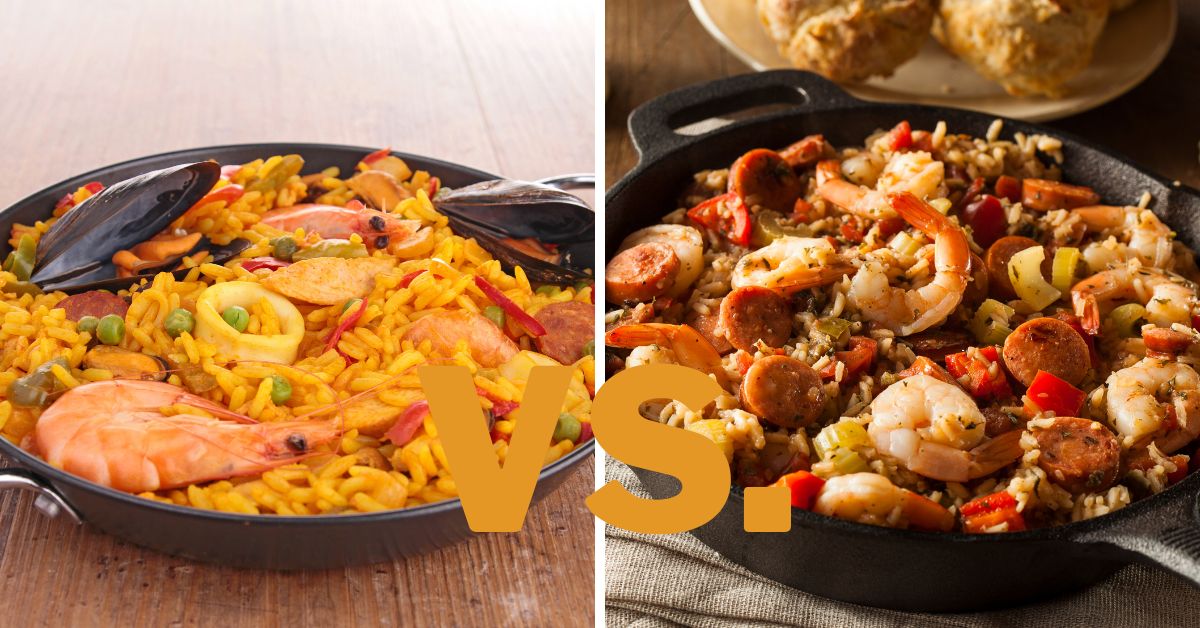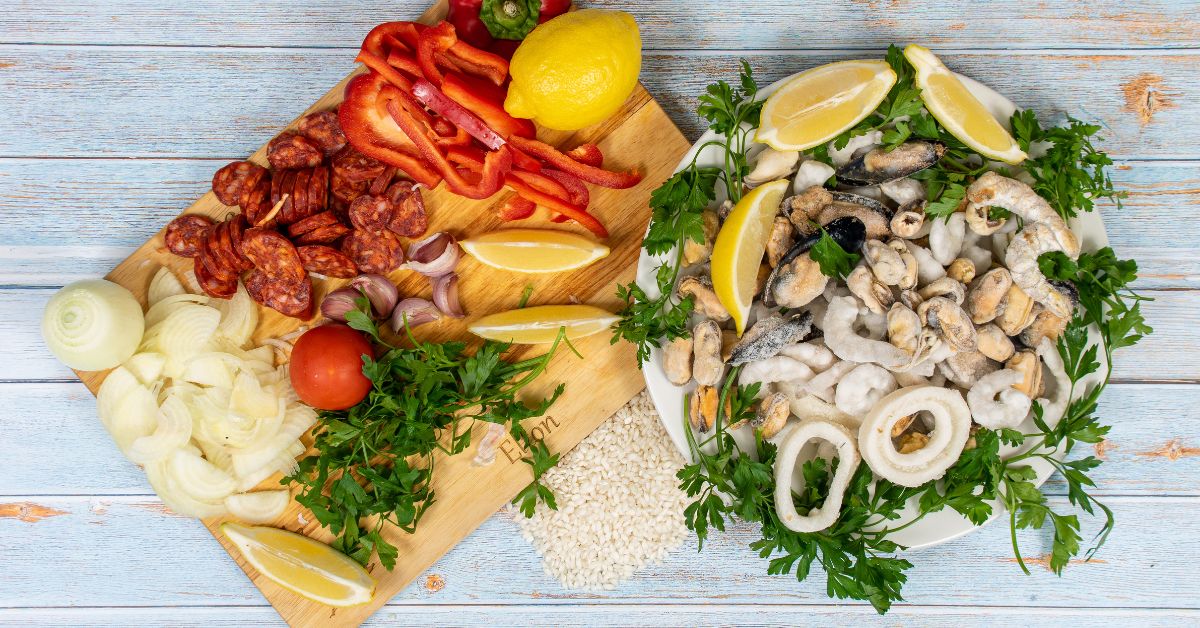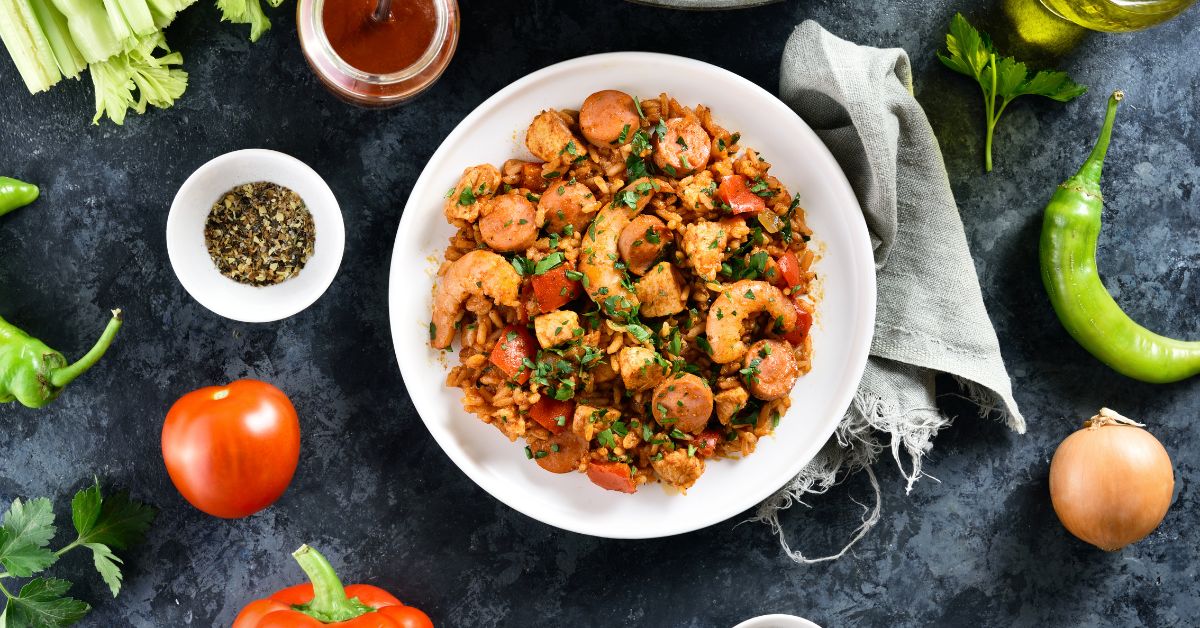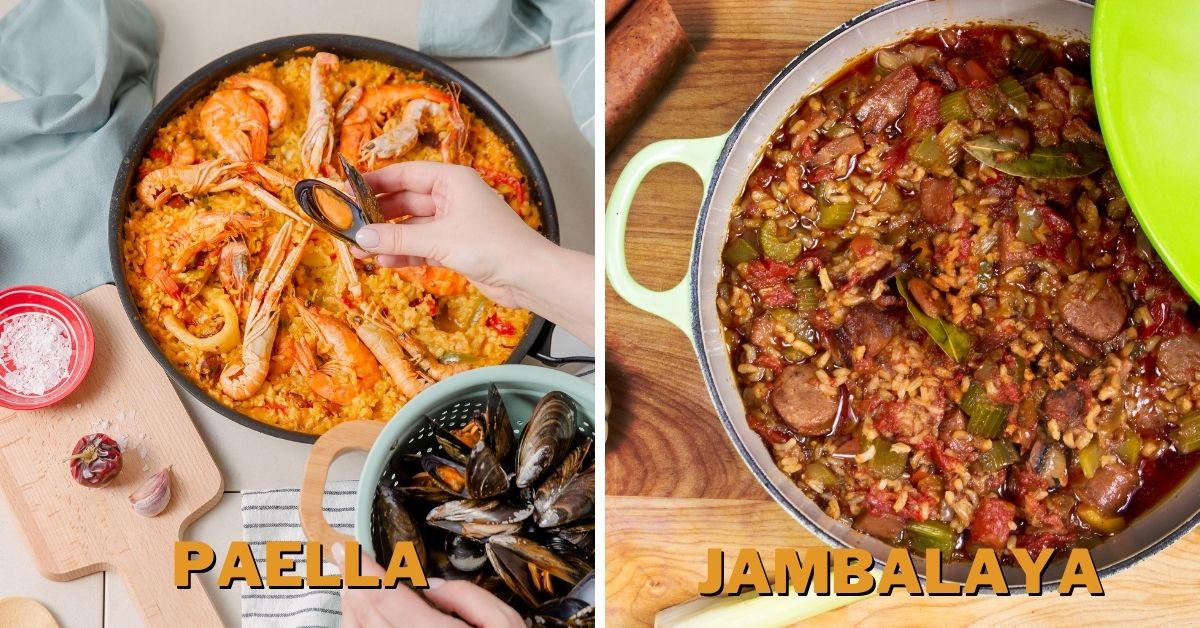Paella vs. Jambalaya: Differences & Which Is Better?

From just reading a basic description, paella and jambalaya seem very similar. They are both one-pot or one-pan dishes with rice, meat, and various vegetables. But does that mean that paella and jambalaya are the same things, just named differently? Or is there more than meets the eye?
Paella is a Spanish rice dish from Valencia, while jambalaya belongs to Cajun and Creole cuisines. Paella uses short grain rice that forms a crust on the bottom. Jambalaya uses long grain rice and is softer. Additionally, paella is yellow in appearance, while jambalaya is either red or brown.
Paella and jambalaya share many similarities yet differ in key areas. And those are the aspects that we are going to be highlighting today. In this article, we will look at both dishes in more detail. We will discuss the origin of these local dishes, typical ingredients, preparation style, variations, taste, appearance, etc.
Paella vs. Jambalaya: Differences
Before we start take a look at a cheat sheet to help you out.
| Features | Paella | Jambalaya |
|---|---|---|
| Origin | Valencia, Spain | Louisiana, USA |
| Type of rice | Short grain | Long grain |
| Color | Yellow | Brown or red |
| Bottom crust | Present | Absent |
| Variations | Seafood paella, Valencian paella | Creole jambalaya, Cajun jambalaya. |
Origin
Paella
Paella comes from Spanish cuisine. In particular, the dish is associated with the Spanish region of Valencia. The people of Valencia consider this to be one of their symbolic dishes. According to Spanish historians, this dish results from the union of two cultures – Roman and Arabic.
The word paella is derived from a Spanish word that means “frying pan”. This refers to the dish being cooked in a large frying pan, usually outdoors over an open fire.
Jambalaya
Jambalaya had its roots in both Creole and Cajun cuisines. It originated from the region of Louisiana, located in southern America. The dish has a mixture of Spanish, French, and African cuisines.
According to the Oxford English Dictionary, the word can be translated as “mishmash” or mix-up. This is likely referencing the dish’s large mixture of various ingredients like rice, meat, and vegetables.
Ingredients
Paella
While different versions of the dish exist, some ingredients are the common thinnest of them. These are rice, tomatoes, green beans, onions, saffron-infused stock, and some form of meat.
The meat can be chicken, pork, duck, rabbit, or seafood. Traditional Valencian paella uses chicken, duck, or rabbit. Seafood paella or paella de marisco utilizes clams, muscles, shrimps, and lobster. You can go one step further and mix livestock meat and seafood to make paella mixta or mixed paella.
Bomba rice is usually the rice of choice when making paella. It is a short grain rice type widely cultivated in Valencia.

Jambalaya
Jambalaya has two major variations, but the difference is mainly one ingredient – tomatoes. Cajun-style jambalaya does not include tomatoes, while Creole jambalaya does. All other ingredients are mostly similar.
All jambalayas start with a base of celery, onions, and bell peppers. These three ingredients form the “holy trinity” of Cajun and Creole cuisines. Then these vegetables are paired with meat, rice, and other vegetables like corn, carrots, and chili.
The meat in a jambalaya dish is typically chicken, pork, rabbit, or seafood. Sometimes, similar to paella, a mixture of seafood and livestock is incorporated into the same jambalaya.
A key distinction lies in the rice used. While paella incorporates short grain rice, jambalaya does the opposite and mostly employs long grain rice. So, long, slender, and usually aromatic rice varieties such as basmati and jasmine are used.

Preparation
Paella
To make paella, you must saute your choice of meat and seafood in olive oil and other herbs. Remove the meat from the pan and saute onions and other vegetables for a few minutes. Then, add the rice and pour in all the stock infused with saffron. Then you let the rice simmer until most of the liquid dissipates.
Finally, you re-add the meat and seafood and let it simmer in the heat for another period until the meat is thoroughly cooked and the rice forms a crust underneath.
Jambalaya
In Creole-style jambalaya, meat and the trinity ingredients are added to the pan, followed by vegetables and tomatoes. The equal parts of rice and stock are added to the pan right at the end. The mixture is brought to a boil and allowed to simmer for 20-60 minutes.
The meat is cooked and browned in a cast iron pot in Cajun jambalaya. The meat is removed, and more oil is added if necessary. Then onions, celery, and bell peppers are added to the same pot and cooked until soft. Stock is added to the pot, and the meat is returned with proper seasoning. This is left to cook for an hour, and then rice is added.
The whole thing is then covered and allowed to simmer over low heat for half an hour. You know the dish is complete when the rice is cooked through.
Serving Style
So, both paella and jambalaya are served in the same dish that they are cooked in. People then scoop up parts of the dish onto plates.
Now, paellas are often served with plenty of lemons. The acidity balances out the spices of the rest of the dish. Peas and other greens are added to make the dish look more vibrant.
Jambalaya is served with some cornbread or salad. Usually, chopped cilantro is sprinkled at the end to garnish the dish.
Variations
Paella
Regarding paella variations, they tend to differ mostly in the type of meat used in them. So, traditional Valencian paella uses livestock meat such as chicken, pork, or rabbits. But you can also make paella with strict seafood, which would make it paella de marisco (marisco meaning shellfish). Clams, muscles, lobsters, crawfish, etc., are all viable for this application.
In a paella mix, you get to combine both livestock and seafood.
Jambalaya
Jambalaya can come in two different styles – Cajun style and creole style. The difference between them lies in the use of tomatoes. Both Cajun and Creole cuisines are native to Louisiana. And while they share several similarities, they differ in many key ways. The use of tomatoes is one of the main and easily noticeable ones.
Creole cuisine will often utilize tomatoes and tomato-based sauces in many dishes. Tomatoes are a very common ingredient in this style. Creole-style jambalaya has plenty of tomatoes, giving it a distinct red color. This is why Creole jambalaya is also referred to as red jambalaya.
Cajun cuisine, on the other hand, is not so abundant in tomatoes. And so their version of jambalaya is also noticeably free from this vegetable. So, if you eat a jambalaya with tomatoes included, you can safely assume that the dish takes more inspiration from Creole cuisine.
Taste and Texture
You will instantly notice a difference in texture when you bite into both dishes. When cooking paella, you intentionally allow the underside of the rice to char a bit t. This forms a crust that is called “socarrat”. Ideally, the rice will reach this crunchy texture without tasting burnt.
In comparison, jambalaya has a more juicy texture. The rice is not cooked in the heat for as long. So, more of the liquid remains in the final dish.
Additionally, jambalaya tends to have more vegetables compared to paellas. The longer grains in jambalaya also give it a more delicate texture.
Appearance
If you know what to look for, you can quickly tell paella apart from jambalaya just by looking at them side-by-side.
Thanks to the infusion of saffron, paella is graced with a yellow complexion. This is most notable when the dish is nearing completion. The underside of the rice is allowed to burn just a little in the pan. This forms a crust on the bottom that has a dark yellow color.
In contrast, jambalaya is either red or brown, depending on its cuisine. Creole style jambalaya is called “red jambalaya” as it includes tomatoes that give it a vibrant red color. Cajun-style jambalaya, however, is notable and devoid of tomatoes. So, the jambalaya remains brownish.

Popularity
Paellas are an iconic part of the culture in Valencia. But the dish is very popular throughout the land. So much, so that many outsiders consider the dish to be Spain’s national dish. Many countries in Europe have also adopted this rice dish.
Jambalaya first gained popularity in the southern parts of America. Louisiana is the main hub for all things authentic jambalaya. But other states also make this one-pot dish at home or in a restaurant.
Paella vs. Jambalaya: Which Is Better?
Both paella and jambalaya are one-pot dishes that are packed with flavor. But they have different features that are more appealing to some than others.
For starters, there are typically more vegetables present in jambalaya. But you can rectify this by incorporating more vegetables into your paella.
In terms of texture, paella offers more variety. The crust on the bottom gives a nice crunch that is a delicious contrast to the soft meat and seafood. But jambalaya has a uniform consistency.
Can You Use Paella Rice for Jambalaya?
Traditionally, paella is made with short grain rice, whereas jambalaya utilizes long grain rice. The short grains aid in forming the crust at the bottom, which is characteristic of a typical paella. Long grain rice is not so conducive to forming that crust.
Paella vs. Jambalaya vs. Gumbo: What Are the Differences?
Both jambalaya and gumbo are typical of Louisiana cuisine. But they are not the same. Jambalaya is a dish that incorporates the rice into the dish by cooking it with the rest of the ingredients. But gumbo is a stew or soup that is often served with rice. The rice is not integral to a gumbo.
In contrast, paella is a Spanish dish where you use short grain rice, saffron-infused stock, and more meat than vegetables.
Is Jambalaya the Same As Paella?
Despite sharing many similarities, jambalaya and paella are not the same dishes. They are indicative of two different cultures and cuisine that use different ingredients and are prepared differently. They both also look and taste differently.
